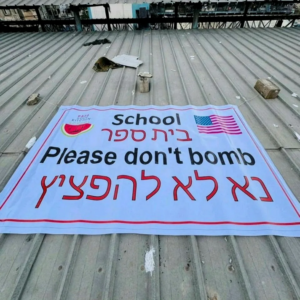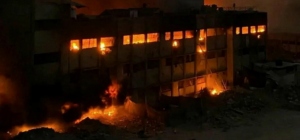Within a month, the Israeli army has destroyed what remained of Gaza’s education system

A banner on the roof of a building in Beit Lahia. Despite the clear sign, the army attacked the structure on 3 November 2024.
Nir Hasson reports in Haaretz on 27 November 2024:
For a short time, it seemed like something positive was happening in Beit Lahia in northern Gaza. On September 24, an organization called Gaza Soup Kitchen opened a temporary school in a commercial building for local children who hadn’t been in school for more than a year.
Volunteers erected classrooms from wooden beams and sheets of plastic, strolled among the rooms dressed up as clowns, and decorated the entrance with balloons. A large sign was placed atop the building, facing upward, so Israeli pilots and drone operators could see it. In Hebrew and English, it said: “School. Please Don’t Bomb”.
The sign didn’t do any good. On November 3, the Israeli Army struck the building, and images from the site show a large hole in the ceiling, next to torn sheets of plastics and wrecked tables and chairs. The army did not provide a reason for the attack, but submitted the incident for review by the General Staff Mechanism for Fact-Finding Assessments (FFA Mechanism), as is done whenever there is concern that firepower was disproportionate or exceeded what is permitted under international law.
The commercial building in Beit Lahia was used as a temporary school because there are hardly any other school buildings left where classes can be held. Many former schools in Gaza, if not destroyed in Israeli airstrikes, are currently used to house displaced persons. UNICEF says that in the past weeks, schools that were still standing were targeted in a wave of attacks that destroyed what was left of the Gazan school system, which will make it harder for society to rebuild whenever the war ends.
According to UNICEF’s figures, between early October and early November, the IDF struck 64 schools and education centers in Gaza, with an average of two attacks daily; in the first 12 months of the war, there were 226 such attacks. The UNICEF report, which relies on information from Palestinian sources, says that 128 people were killed in these attacks over recent weeks, many of them displaced persons who had taken shelter in the school buildings. Most attacks were airstrikes in the northern quadrant of the Gaza Strip, where the IDF has been carrying out an extensive ground operation since October 5, pushing the population to move southward.
Palestinian and international officials are convinced that the repeated attacks on school buildings, particularly in northern Gaza, are part of an IDF policy aimed at depopulating the area. As part of its attempt to get the local population to leave the area, the army halted all shipments of food and humanitarian aid north of Gaza City, except for vital supplies for one hospital. Nonetheless, the UN estimates that there are still tens of thousands of people there who either cannot or do not wish to leave.
In one incident, the Khalifa bin Zayid School in Beit Lahia was attacked on October 17. A video of the school in flames went viral, and Palestinian health officials told Reuters that 19 people were killed. On the same day, the Abu Hussein School in Jabalya was also attacked; the BBC reported, quoting sources in Gaza, that 28 people were killed. An Al Jazeera report from the nearby hospital showed wounded and dead being brought in by ambulance as well as by mule-drawn wagon.
Two days later, on October 19, the IDF struck the Asma School in the Shati refugee camp. Palestinian sources reported that seven people were killed in the attack, and the Washington Post website posted a video showing locals searching for survivors in the rubble. Then, on October 20, the IDF struck the UN-run Hafasa School in Jabalya. Palestinian sources reported an unclear number of casualties.
October 21 was the most intense day of attacks. For unknown reasons, on that day, the IDF attacked six schools, all in the northern part of Gaza. Three of the six were attacked from the area; a total of 20 people were reportedly killed as a result. Nabeen al-Dawasa, a paramedic who works in the Jabalya refugee camp, talked about the attack on the UN-run Al-Fawaka School there. She said the army used the loudspeaker system to call on people to leave the building, but didn’t give people enough time to escape. “Less than 10 minutes after the warning, missiles were falling on us,” she said.
The three other schools went up in flames. Local residents say that soldiers torched them, either deliberately or in the course of battle. Palestinian journalist Younis Tirawi posted three pictures online of schools on fire. In one, soldiers can be seen standing in front of the flames. The BBC corroborated two of the pictures and said that, based on satellite images, it had confirmed that schools were set on fire on those days. Israeli forces entered three of the schools, in Jabalya and Beit Hanoun, and told the families that had taken shelter there to evacuate southward. According to reports, men were separated from their families and taken for questioning.

A burning school in Jabalya, Gaza, 21 October 2024
Palestinians claim that there were other instances in which Israeli soldiers set schools on fire. The case about which there is most concern is the Mahdia al-Shawa School in Beit Lahia. On November 11, a convoy of trucks from the UN food program arrived at the school. This was the first food convoy to enter the city since the start of the operation five weeks before that, and there was great excitement among the local people. Dozens of people apparently crowded around the trucks to get the supplies.
After the UN personnel left, reports began to come out of Israeli attacks near the school, which forced the civilians there to flee. Afterward, local residents and international organizations said that Israeli forces entered the place. Three days later, a video taken by a soldier was posted online showing two IDF armored vehicles leaving the school area while the building went up in flames. Palestinians and international personnel in Gaza believe the soldiers set the building on fire. The army said the school was used to shelter terrorists and that after the civilians were evacuated, dozens of terrorists there were arrested and “as a result of the activity there the building caught fire.”
Haaretz contacted the IDF about 18 attacks on schools that occurred between early October and early November. The army responded that all the cases, including those described above, have been submitted to the FFA Mechanism for further examination. This department was established to rebuff demands from the international community to investigate Israeli soldiers on suspicion of committing war crimes. Human rights organizations assert that, based on experience, this body will not pursue criminal investigations and is intended to whitewash illegal actions.
According to UNICEF, 95 percent of the schools in Gaza have been damaged in IDF attacks and 87 percent will need extensive repairs before they can be used again. In a statement issued this month, UNICEF said, “At least 658,000 school-age children in Gaza have being cut off from all formal learning, casting a pall of uncertainty over their future; they are living in emotional distress and are at heightened risk for child labor and underage marriage.”
Since the war started, the vast majority of children in Gaza have not been in school. 12,400 students, less than two percent of the school-age population, attend temporary schools erected by UNICEF in the tent cities that are housing displaced persons. “We give them a basic education, math and reading, but mainly emotional aid. These children have seen things that children are not meant to see. Many have been evacuated from their homes several times,” says UNICEF Chief of Communication Jonathan Crickx.
Crickx says that he was in Gaza “in February and in September. In February, you could still see a few children smiling. By September, it was much more depressing. You see entire neighborhoods in ruins, children hauling jerrycans of water and trying to collect a little food or water for the family. As time goes on, hope in Gaza dwindles.”
The IDF Spokesperson replies, “Hamas operates under cover of civilian infrastructure, including schools. In the course of the war, buildings that once served as schools were found throughout Gaza – buildings which Hamas used before and during the war for terror purposes; this proved once again that Hamas is using civilians as human shields.
“The IDF does not deliberately attack civilians or civilian infrastructure. It operates in a focused manner to degrade Hamas’s capabilities, to strike its militants and destroy its terrorist infrastructure, while upholding international law and striving to limit harm to civilians. Specifically, an attack on military targets located in civilian sites, including schools, is carried out following a comprehensive process of obtaining approvals and while taking as many precautions as possible under the circumstances.
“All the incidents cited in the query are being reviewed by the FFA Mechanism that investigates unusual operations to study them and draw lessons from them and factually assess them, and to examine whether there is any suspected violation of orders, or of the law. When the review is completed, the findings will be submitted to the military prosecutor.”
This article is reproduced in its entirety
